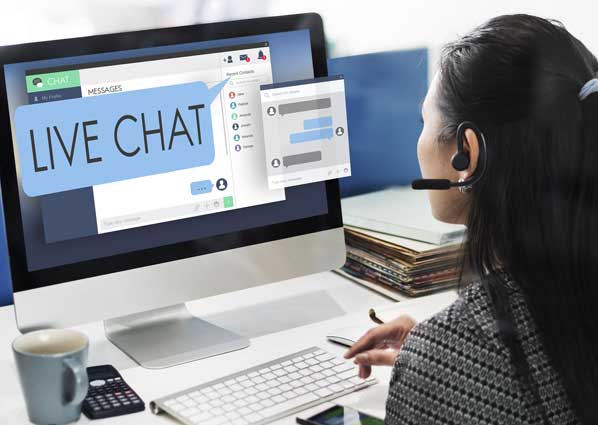
Live chat is a way for your business to engage with your website visitors. You can use live chat software to initiate conversation with first-time website visitors, interact with returning customers, and support your existing users in real-time.
Using live chat software for your website is like giving your customers a way to talk to your business through WhatsApp, Facebook Messenger, or other social media channels.
Live chat helps you respond to your prospects and customers on time; thereby, improving engagement as well as satisfaction. Having live chat software like Freshchat helps businesses close more deals and reduce churn and improve profitability.
Is live chat better than phone support?
For many years, email and phone support have been the default tools of choice for helpdesk teams across industries. However, live chat software is revolutionizing the way helpdesks respond to their customers because it is instant, more contextual, and more personal.
A research by Forrester states that using live chat software for customer support is 17-30% cheaper than phone. A helpdesk support can easily handle 4-5 customer chats concurrently while phone is always one-on-one. Live chat is also more accessible, responsive, and faster than phone support. Also, support over phone is often long winding because customers have to pass through the massive phone tree in order to reach the right support team. With live chat, they can do so within just a few clicks.
Live chat for support enables you to have a 24/7 virtual support system. This helps in reducing backlogs of your support agents and improving your overall response time. Your support team can prioritize issues by enabling push notifications that can help in analysing the extent of the issue with the click of a button.
Live chat vs email
Live chat is as interactive as phone conversations while being just as relaxed as email messages. But while the average benchmark for first response time on emails is around 24 hours, it is less than 3 minutes for live chat – across all industries. Cost wise, live chat software doesn’t cost much than setting up email support for your business.
With a modern live chat software, you can do everything that you would expect from an email; share rich media files, send links, follow up on conversation threads. But unlike emails that can get buried in a heap of other agendas in your inbox, live chat is continuous. You don’t have to navigate through a mountain of conversations to find the last chat with a customer. Once the customer initiates a chat, both they and the helpdesk agents can pick up from where they left off.
Who needs live chat?
Customers need live chat to get quick answers to their questions on a website. Marketing and sales teams need live chat to collect leads and convert them into customers. Helpdesk teams need live chat to quickly solve customer problems, support them, and engage them better.
Live chat is incredibly valuable for e-commerce businesses to capture leads, reduce bounce rate, and bring down the number of cart abandonments. Similarly, live chat software helps B2B businesses such as SaaS companies launch contextual marketing campaigns based on real-time user behavior, deploy interactive chatbots to engage with them, or offer proactive support.
In today’s competitive market, live chat software is a must for all businesses who want to boost sales, reduce website churn, and offer world class customer support.
Various research shows that the ROI rate from live chat software for sales teams is about 300%. Live chat also increases conversions by 20%, mostly because customers often say that they are more likely to shop in a website that offers live chat support. Online businesses who want to stay closer to their customers for sales, support, and feedback should not ignore the power that live chat offers. Live chat is extremely beneficial for businesses that want to offer instantaneous and personalized services to their buyers.
How can a live chat software help your business?
Regardless of what kind of business you do, if you have set-up an online storefront with an aim to generate more sales or offer support to your customers, live chat can add great value. Here are three real-world use cases of how websites use live chat in their everyday business:
Use case #1: Live chat software for lead generation
The presence of live chat software like Freshchat for a business is comforting for visitors. This lends credibility to your brand as it ensures visitor queries are handled proactively. It is also a subtle way of making your brand reach many people. By having a live chat widget in your website, you open doorways for them to approach the brand while exposing your business to a multitude of lead gen opportunities.
For example, say a prospective buyer comes to your website to buy something outside of your business hours. So you pre-program a chatbot to engage with the prospect, get their email address, and automate the collected data to your CRM software. This is much better than having a form in your website because it’s interactive and engaging for visitors.
Use case #2: Live chat software for website
If you own a business that primarily depends on a website for conversion, you need to focus on meaningful conversations that can aid in improving conversion rates. It takes very little time to embed a live chat into your website. Once this is done, it’s about setting workflows that can help your sales team close more deals.
For example, you can launch proactive messages to visitors coming to your website to help them interact more with your product. Similarly, you can improve your self-service offering by setting up pre-configured message channels or integrating FAQs within the chat widget.
Use case #3: Live chat software for e-commerce
It is vital for e-commerce businesses to turn every visitor into a repeat customer. This forms the crux of a successful e-commerce business. Personalizing user experience for a visitor goes a long way in ensuring repeat visits. You can achieve this by using live chat software that can help you get in touch with a customer at important moments during a visitor’s purchase journey.
Let’s say, for example, a customer abandons her shopping cart right before she was about to make a purchase – for whatever reason. With live chat, you can set contextual trigger messages based on user behaviors to coax them to take certain desirable actions. In this case, you can trigger a chat notification offering her an attractive discount. Or, you can send her a temporary link to complete the payment process if she was having trouble proceeding with the checkout.
Use case #4: Live chat software for SaaS
The adoption of live chat software in the Software as a Service (SaaS) space has been constantly increasing as companies look to get better at proactive customer engagement. Companies are looking at personalized experiences through chat which makes visitors improve their engagement on the website.
It could be a visitor coming to your pricing page and with queries about your subscription plans. Rather than making her wait, you can deploy a chat pop-up that can connect her with a live agent to help answer her pricing queries. This directly improves your chances of converting the user at the right time.
Embrace the power of live chat
Businesses today need to maintain high-touch contact with their customers to stand-out from their competition who offer products and services that are very similar in quality and offering. Businesses need to be adept at building good rapport with customers and answering their queries on a timely, quick, and personal fashion in order to develop a USP for their brand and create a differentiator that makes them special among the generic tribe.
Live chat software gives you control of building meaningful relationships and being accessible to your customers when they need to reach out to you. Embrace the benefits live chat software offers to your business and reap the rewards of conversing with customers in a genuine way.
About the Author
 Manish is a content marketer for Freshchat, a modern messaging app for marketing, sales, and support teams. He loves writing on topics related to tech, automation, online security, and marketing in general. He studied journalism in college but fell out of love with it relatively soon. When he is not working on getting his next article out, he is busy baby-talking with his three-and-a-half-year-old daughter or lacing up his shoes for the next marathon practice.
Manish is a content marketer for Freshchat, a modern messaging app for marketing, sales, and support teams. He loves writing on topics related to tech, automation, online security, and marketing in general. He studied journalism in college but fell out of love with it relatively soon. When he is not working on getting his next article out, he is busy baby-talking with his three-and-a-half-year-old daughter or lacing up his shoes for the next marathon practice.




